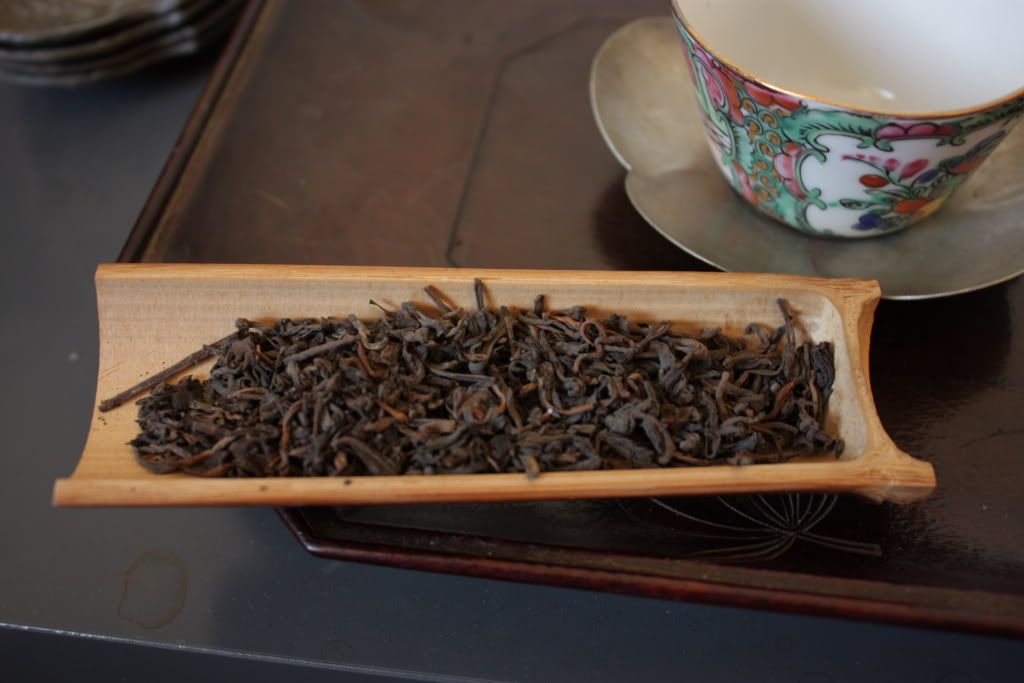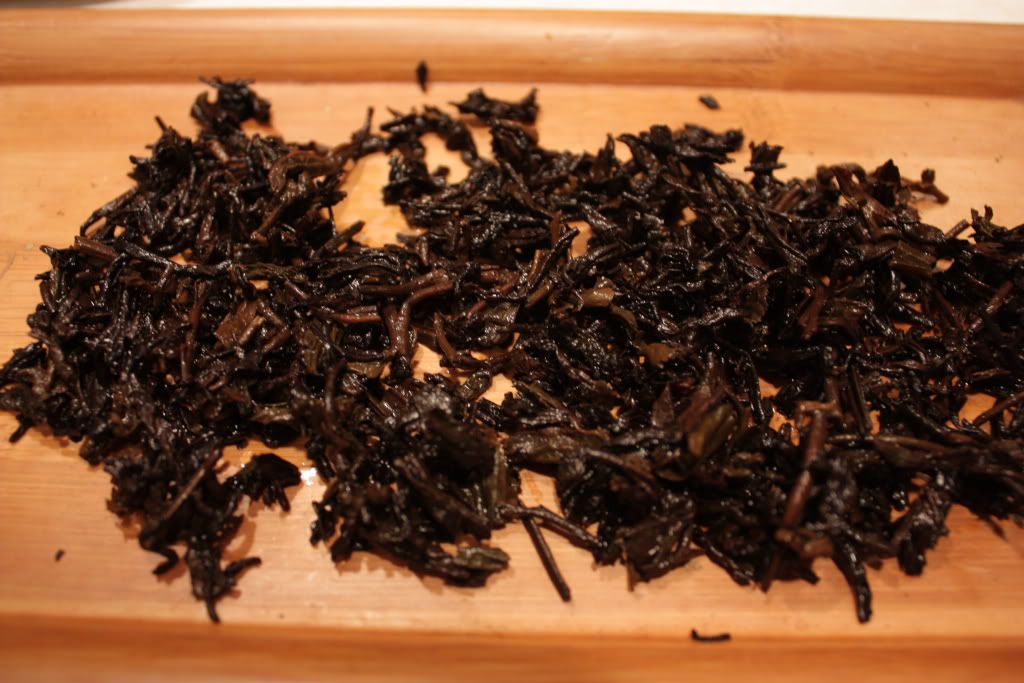* This is a column entry that will go into the latest issue of the magazine my friend edits in Beijing, but you’ve seen this here first. Some of them are points that I’ve made before in various forms, so sorry for boring those of you with a good memory :).
For the past few years, puerh has been a typhoon that swept through the tea drinking community. Almost everybody, from old hands to newcomers, were swept up in its wake. Interest in this tea skyrocketed, and for a while, a bubble formed with the puerh market. Although things have subsided somewhat in the past two years, there is still plenty of interest and the landscape of puerh production, consumption, and storage has been permanently altered.
One of the issues at hand, storage, is a complicated matter that has led to much ink being spilt. Definitions of good and bad storage differ, and commercial interests, unfortunately, are heavily involved as old tea fetches astronomical sums. Those who have one sort of tea will claim it is the best, while some others who own another type will claim that in fact, theirs is the best. Confusion, unfortunately, is the name of the game.
Among questions on storage and tea condition is the perennial issue of “wet†vs “dry†storage. Both wet and dry are relative terms, and run from a scale of absolute dryness to liquid water. So, what exactly constitutes dry, and wet, storage? Unfortunately, definitions differ considerably, and are largely dependent on where one’s from. Let me try to summarize what I have found so far from personal experience:
1) Hong Kong/Macau
As the inventor of wet storage, people from Hong Kong and Macau tend to have a fairly strict definition of what it entails. I think largely we can summarize it as puerh that has been stored in an artificially wet condition with elevated temperature, for the specific purpose of speeding the aging of the tea and to change the character of the tea in question. This is sometimes also called “ground storage†as many of these storage facilities were basements or built into a hill.
Until maybe ten or fifteen years ago, there was no such thing as “wet†or “dry†storage. A friend of mine who has been drinking tea seriously for twenty years told me that when she first started learning about puerh, she, and some friends of hers, went to some of the very old shops in Hong Kong to search out puerh cakes. They wanted, however, to find cakes that were green – young cakes, so that they can store it themselves. When they asked, the storekeepers generally gave them a strange look, and asked why on earth would they want such a thing – these teas are undrinkable! Needless to say, their expedition was unsuccessful. Nowadays, it is much easier to find raw cakes that have not gone through such storage, but back then, it was nearly impossible.
These days it is much easier to find such cakes that have not gone through such storage condition. For the most part, private collectors or tea investors generally try to store them in a natural environment. What this means is that the storage space is not artificially enhanced with moisture or temperature, but just left alone to the natural cycle of the weather. My friend who tried to buy her tea in the 1990s has been doing that for a dozen years, and is now enjoying the teas that she has in her collection, some of which are very nice. This, to people from Hong Kong anyway, are what is generally called dry storage.
2) Taiwan
When I was in Taiwan doing research I noticed that they have a varied amount of terminologies used to denote different types of storage conditions. One of them is “Hong Kong storageâ€, which to them means wet storage. However, I have noticed among friends and shops that many teas that are so called “Hong Kong storage†were in fact stored in Taiwan. Taiwan, it must be remembered, has even wetter conditions than Hong Kong. Humidity is higher in many parts of Taiwan, and rainfall is continuous for weeks at a time. For dry storage, there is also a nuanced distinction between just regular, natural storage, and storage that sometimes includes climate control.
I remember in about November when I was in Taipei, the weather had turned cooler, but not cold. I usually left my window open in my 8th floor apartment during the day. There was a week when rain fell almost daily. The bulk of my tea cake collection was sitting on a loft area, far away from the window, but two or three cakes I left underneath the coffee table for easy access as I was drinking them. They were wrapped in their original wrapping paper and sat at least a foot off the ground and a few feet away from the window. The cakes were certainly not touched by water at any stage. Yet, in about two weeks, I noticed that the cakes were quite damp, and that there was the first signs of mould growing on the cake. This, to me, was quite an interesting discovery, because it showed that in a natural environment, away from direct contact with moisture, it was still possible to have mould growing on tea in a place like Taipei (and remember, I was on the 8th floor, not in a basement). So, even if a tea is “dry†stored, it is worth keeping in mind what that means for the tea.
3) Northern China
When I was in Beijing doing research, I lived there for a year. In that year, I spent probably more time trolling the tea markets than anything else, and was able to gain some insight into not only the tea market but also what people thought about what they were selling and drinking, largely through talking to a wide variety of people, from girls who came from tea farms in Yiwu to Beijing entrepreneur-turned-tea merchant. While this does not mean that what I found was a China-wide phenomenon, I do think that there’s some representation in terms of Yunnanese views as well, as Kunming is also a very dry climate (although not nearly as cold).
Basically, anything stored in Southern China is considered wet. I remember trying a few teas that were maybe about 10 years old by Southern China standard and certainly dry stored (again, by that standard). The almost unanimous response was “this is wet stored†and “this is poorly storedâ€. They demand a very dry kind of storage up north, where teas change very slowly and retain much of their original character through storage, mellowing very, very slowly. If you show them truly wet stored (i.e. ground storage) teas, they often think it is cooked puerh, or simply don’t recognize what they’re drinking.
Part of this, I think, is historical. Puerh really wasn’t consumed outside of a few provinces in the south and Southeast Asia, and so the experience of the Beijingers have been much shorter, generally (at this point in 2008) about five years old or so. Prior to that, they drank light tieguanyin, and before that, longjing, and a little further back, jasmine. Their tastes tend to the fragrant and light side of things (perhaps an antidote to the heavy food) and I think this preference shows itself in their choice of puerh as well.
4) The Occident
So what is wet storage in the Occident? Well, I can’t speak for everybody, but I think a survey of the internet is probably a pretty good approximation of what the consensus is.
To put it simply, there isn’t a consensus from what I can see. There are varying definitions of what “wet†or “dry†storage means, and different vantage points with which to view this issue. There are a few issues that complicate this problem. First, like Beijing, experience with puerh drinking in the West is certainly thin. Moreover, information is hard to come by, with a lot of it being provided by vendors who sell tea. Another problem, and I think this is a critical issue, is the lack of experience among drinkers who ca
n differentiate the different kinds of storage. While I was lucky to be guided by more experienced hands, and have had the opportunity to drink a wide variety of teas, many in the West rely solely on retailers who sell through the internet. The teas being sold through this medium are, for the most part, young cakes that are under 10 years of age. There is also a selection bias in the inventory of such vendors, and so they often only reflect one philosophy with regards to proper storage condition.
What I find generally true is that “wet†storage has been largely seen as a bad thing – it is believed that it affects the tea negatively. I have also seen an interesting obsession with the idea that teas need to retain their “true†“authentic†flavour, and “wet†storage is seen as something that will tamper with the purity of the tea. To that end, “dry†storage is seen as ideal – it retains the flavour of the original tea and thus is “betterâ€.
Long time reader of this blog probably know that I don’t necessarily subscribe to this view. In particular, I do not believe that it is important to keep the original flavour of the tea in order for the storage to be successful. If anything, the point of storage is to change the flavour of the tea away from its original character, which is often harsh and bitter, into something that is sweeter, softer, and mellower. The degree to which this change should take place varies by individuals. However, I think it is not the best idea to think that teas should be kept in a largely similar condition to when it was purchased. If that is the goal, the best choice is to buy well sealed tieguanyin or green tea and drink it when appropriate.
What I think it comes down to is a problem of transmission of information – whereas it is possible to drink a lot of different kinds of teas, talk to a lot of people, read a lot of books, and see a lot of cakes if you’re in Taiwan, China, or Southeast Asia, in the US or Europe, the choices are extremely limited, prices are almost always high, and information hard to come by. What little that exists are fragmentary and prone to personal biases (including, of course, mine). There’s hope for optimism though, as years pass we all gain experience storing teas and buying teas, and give them a few more years, we will start seeing the results of storage conditions in places as disparate as Pairs, Florida, and Los Angeles. Some are bound to be disappointed, and it might not have anything to do with storage conditions as the quality of raw materials also plays a significant role. Hopefully we will all come out richer in knowledge.









Yeah whisky prices have been leaking too, as well as luxury watches. I wrote a post maybe a decade ago…